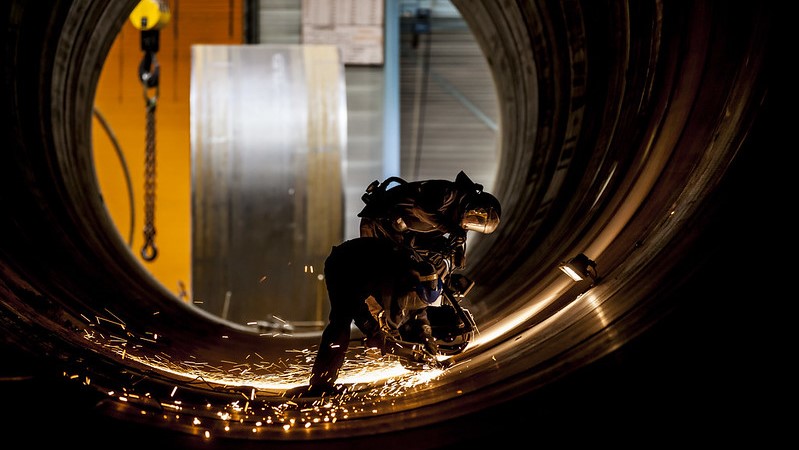Government departments and entities are big spenders – including on infrastructure from the construction of new roads and bridges to social housing, schools and hospitals.
This purchasing power means that what they decide to buy (or not) can influence the market and what products businesses offer. This is why green public procurement can play a big role in achieving climate goals.
Currently, government procurement, industrial, energy and climate policies are not always aligned. This must, and can, change – and thankfully there is new international momentum to make this happen. When it comes to responding to climate change, we must all move (as quickly as possible) in the same direction.
Globally, many countries are still industrialising and urbanising. The world is expected to build the equivalent of another New York City every month for the next 40 years. Decarbonising construction, and reducing the carbon intensity of common materials like steel, cement and concrete, is thus an unavoidable imperative.
These materials have long been key building blocks in construction projects across the world. They also currently account for an estimated 50% (at least) of global annual industrial greenhouse gas emissions. Switching to lower-carbon versions of these materials can thus make a big difference on global emissions.
Scaling up renewables means big changes to electricity networks
Estimates suggest, for example, that if even 35% of the steel used in public construction projects was very low-emission, and 60% of the cement used was very low-emission, it could save the world 1.25 billion tons of carbon emissions a year – more than total global carbon emissions from commercial aviation in 2019.
Together, national, regional, and local government entities account for an estimated 20-30% of total construction industry revenues, and 40-60% of total concrete sales. Buying greener products can cut carbon from their own projects – and make a wider impact by sending markets signals that demand for these products is rising.
This can help mitigate the risks that companies take when they invest in the innovation and adoption of greener technologies. We have seen this happen successfully before – in the case of solar energy, for example.
Solar technology used to be very expensive. This changed after countries committed to renewable energy targets and after some, such as the United Arab Emirates, built large-scale solar plants with transparent tenders and contracting processes that helped to dramatically drive down the cost of this technology. Similar strategies and impacts are needed in the global construction industry and for its basic materials.
Governments have processes to evaluate potential materials for their construction projects – and these materials’ carbon footprints have to be part of that criteria. In order to do this – and make informed decisions and monitor impacts – procurement officers need common definitions, harmonised data and measurement standards.
Some companies are racing to install the first commercial-scale facilities for greener steel and cement, and to implement new carbon capture technologies. But we need many more to join them, to actually meet our climate goals.
The good news is that there is new international momentum to help them. At the 2021 Clean Energy Ministerial, a new coalition of governments and private sector entities emerged to focus on decarbonising heavy industries, starting with steel, cement and concrete. This is the Industrial Deep Decarbonisation Initiative (IDDI).
Coordinated by the UN Industrial Development Organization (UNIDO), IDDI aims to stimulate demand for low-carbon materials. Current member governments include Canada, Germany, India, the United Arab Emirates, and the United Kingdom – as well as the United States and Saudi Arabia which joined last week.
Gap to 1.5C yawns, as most governments miss UN deadline to improve climate plans
At this year’s Clean Energy Ministerial, during the Global Clean Energy Action Forum in Pittsburgh, Pennsylvania (21-23 September), IDDI released a new global Green Public Procurement Pledge including targets for governments to increasingly procure low- and near-zero emissions cement, concrete and steel for their public projects.
Most immediately, the pledge asks governments to start monitoring and disclosing ‘embodied carbon emissions’ – those from the production through to the use – of these materials by 2025. They are then asked to use low-emission materials in all public projects (and near zero-emission materials in signature ones) by 2030.
The longer-term goal is to achieve net-zero emissions by 2050. A lot of work is needed to get there, however, as we’ll need to see a global wave of new technologies emerge, be installed and implemented to lower carbon intensity. These technologies will need to be as accessible and affordable as possible.
So far, green public procurement has been an underutilized tool for achieving climate goals. This should change in as many countries as possible, as soon as possible – and we should help each other to make this a reality. We must move towards net-zero goals within our own countries – and across the world.
Rana Ghoneim is the head of Energy Systems and Industrial Decarbonization Unit at the United Nations’ Industrial Development Organization (UNIDO). She is also coordinator of the international Industrial Deep Decarbonization Initiative (IDDI) which released the global Green Public Procurement Pledge focused on steel, cement and concrete.
